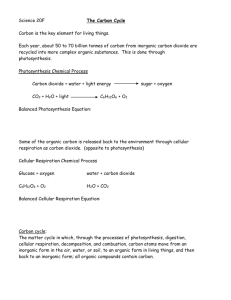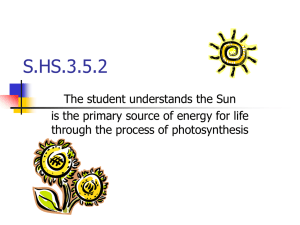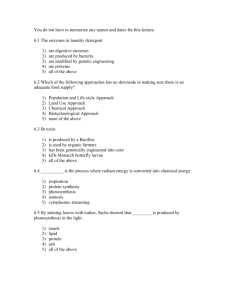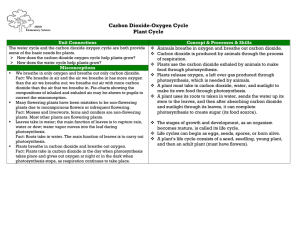Producers Lab- Photosynthesis
advertisement
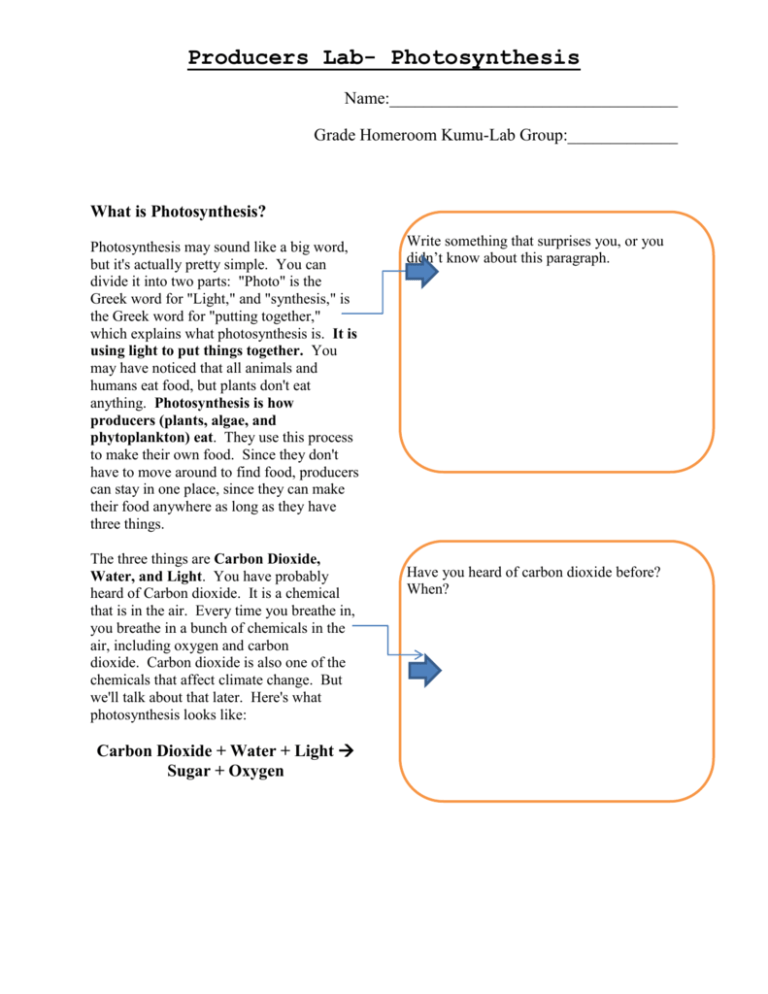
Producers Lab- Photosynthesis Name:__________________________________ Grade Homeroom Kumu-Lab Group:_____________ What is Photosynthesis? Photosynthesis may sound like a big word, but it's actually pretty simple. You can divide it into two parts: "Photo" is the Greek word for "Light," and "synthesis," is the Greek word for "putting together," which explains what photosynthesis is. It is using light to put things together. You may have noticed that all animals and humans eat food, but plants don't eat anything. Photosynthesis is how producers (plants, algae, and phytoplankton) eat. They use this process to make their own food. Since they don't have to move around to find food, producers can stay in one place, since they can make their food anywhere as long as they have three things. The three things are Carbon Dioxide, Water, and Light. You have probably heard of Carbon dioxide. It is a chemical that is in the air. Every time you breathe in, you breathe in a bunch of chemicals in the air, including oxygen and carbon dioxide. Carbon dioxide is also one of the chemicals that affect climate change. But we'll talk about that later. Here's what photosynthesis looks like: Carbon Dioxide + Water + Light Sugar + Oxygen Write something that surprises you, or you didn’t know about this paragraph. Have you heard of carbon dioxide before? When? Producers Lab- Photosynthesis Plants gather their materials differently than animals. What do you think about how plants gather ingredients to survive? Plants breathe, just like us. They even have little openings that can look like mouths, but they are too small for us to see without a microscope. When we breathe in, we want to breathe in oxygen. Plants want to breathe in Carbon Dioxide. Plants also drink. This is why you need to water plants or they will die. They use their roots to suck water up into their bodies, and their little mouths to breath in the carbon dioxide. Once they have both of these things, all they need is light. Leaves are made up of a bunch of tiny cells, where this happens. Inside the cells are tiny little things called chloroplasts. Chloroplasts are what makes leaves green, and they are also what takes the carbon dioxide, the water, and the light, and turns them into sugar and oxygen. The sugar is then used by the plants for food, and the oxygen is breathed out into the atmosphere. This process as a whole is "photosynthesis." Producers Lab- Photosynthesis Photosynthesis poster lab: Your group will need to work together and be creative to make an amazing photosynthesis poster. Your scientific problem is to make a poster that explains photosynthesis in a creative way. *Remember that photosynthesis is like making a cake if you forget one of the ingredients then you won’t get a cake. Materials: Large paper Leaves of plants that make photosynthesis Carbon Dioxide Air(Oxygen) Sun light Markers Glue Scissors Procedure: 1. Get a large piece of paper to make the poster. 2. On the back, write all the group members first and last names, grade, homeroom Kumu and lab group. 3. Gather all the materials. 4. Go outside and collect the leaves that will be used for the posters plants (make sure they are plants that use photosynthesis). 5. Recheck to make sure that all the materials are collected. 6. Cut out the carbon dioxide and air (oxygen) pieces. 7. Layout how the group wants the poster to look (remember the poster is meant to show others how photosynthesis works). 8. Before gluing anything down, make sure Kumu checks the poster. 9. Finally, complete the poster, adding any final touches. Producers Lab- Photosynthesis What does this information remind you of? Information about Photosynthesis This happens to EVERY plant, and to some bacteria and algae, too. Without photosynthesis, plants wouldn't exist. Humans and animals do the exact opposite of photosynthesis. They breathe in oxygen and breathe out carbon dioxide. This means that we give plants more carbon dioxide, and they give us more oxygen. Without plants we wouldn't be able to survive, but there is enough carbon dioxide in the atmosphere that plants would still exist without us! Before there was photosynthesis, there wasn't much oxygen in our atmosphere. So before plants evolved the ability to turn water and carbon dioxide into sugar and oxygen, there was no way for plants and animals to exist. Before photosynthesis, bacteria and other living things used other chemicals to make their food. But when photosynthesis started, it worked really well, so organisms (living things) that had photosynthesis thrived and evolved into plants and trees. As more plants grew across the planet, more and more oxygen went into the atmosphere, meaning that animals were able to start evolving! We would never have existed without photosynthesis. The atmosphere is full of carbon dioxide. Carbon dioxide is a greenhouse gas, meaning that if it is in the atmosphere, it holds heat close to the earth, which makes our planet warm. If we didn't have carbon dioxide, we wouldn't be a warm planet; we would be cold like the moon. If we had too much carbon dioxide, we would be like Venus, which is a really hot planet. Plants keep our atmosphere from getting too much carbon dioxide and heating up by turning a lot of it into oxygen. Producers Lab- Photosynthesis Answer each question in complete sentences. 1.What is a producer? Please give an example of a producer also. 2.How do producers convert sunlight energy into food? 3.Why do producers need photosynthesis to survive? 4.What are the necessary ingredients plants need for photosynthesis? 5. Photosynthesis makes two things, what are they? Producers Lab- Photosynthesis Conclusion: (In at least 5 sentences, explain what producers are, why the use photosynthesis to make energy, what you did in this experiment and something interesting that you learned.)




